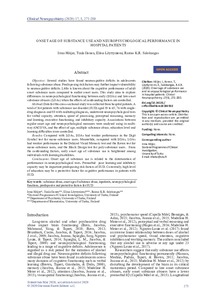Onset age of substance use and neuropsychological performance in hospital patients
Irma Höijer; Tuula Ilonen; Eliisa Löyttyniemi; Raimo K.R. Salokangas
Onset age of substance use and neuropsychological performance in hospital patients
Irma Höijer
Tuula Ilonen
Eliisa Löyttyniemi
Raimo K.R. Salokangas
Giovanni Fioriti Editore
Julkaisun pysyvä osoite on:
https://urn.fi/URN:NBN:fi-fe2021042826188
https://urn.fi/URN:NBN:fi-fe2021042826188
Tiivistelmä
Objective: Several studies have found neurocognitive deficits in adolescents following substance abuse. Predisposing risk factors may further impact vulnerability to neurocognitive deficits. Little is known about the cognitive performance of adult onset substance users compared to earlier onset users. This study aims to explore differencesin neuropsychological functioning between early (EOAs) and late onset substance abusers (LOAs) when the effects of confounding factors are controlled.Method: Data for this cross-sectional study was collected from hospital patients. A total of 164 patients with substance use disorder (SUD) aged 19 to 65, 76 with single-drug diagnosis and 88 with multidrug diagnosis, underwent neuropsychological tests for verbal capacity, attention, speed of processing, perceptual reasoning, memory and learning, executive functioning, and inhibitory capacity. Associations between regular onset age and neuropsychological measures were analysed using in multi-way ANCOVA, and the effect of age, multiple substance abuse, education level and learning difficulties were controlled.Results: Compared with LOAs, EOAs had weaker performance in the Digit Symbol test for mono-substance users. Meanwhile, compared with EOAs, LOAs had weaker performance in the Delayed Visual Memory test and the Raven test for mono-substance users, and the Block Design test for poly-substance users. From the confounding factors, early onset age of substance use is heightened among individuals with learning disabilities.Conclusions: Onset age of substance use is related to the deterioration of performance in neuropsychological tests. Premorbid poor learning and inhibitory capacity may be important predisposing risk factors of SUD. Conversely, high level of education may be a protective factor for cognitive performance in patients with SUD.
Kokoelmat
- Rinnakkaistallenteet [27094]
